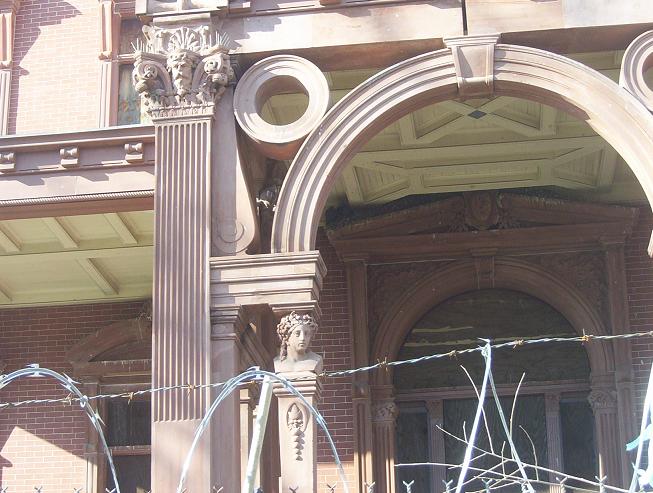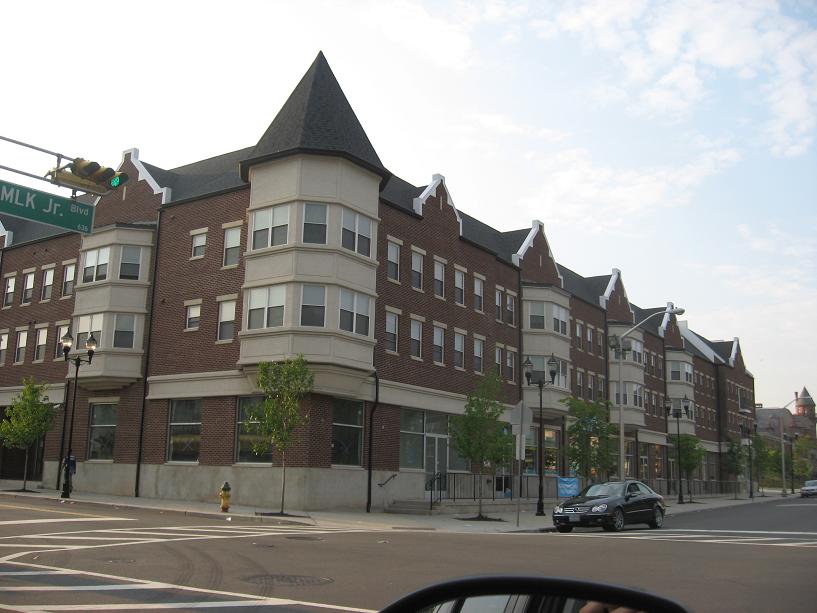High Street/MLK Boulevard: Part I
Text and HTML by Jeffrey Bennett. Photos by Jeffrey Bennett and David Druce.
February/March 2007.
a tour of the southern half of Martin Luther King Boulevard, formerly High Street. This is presently a low-income area, but there are signs of revival everywhere. While there is new construction to be seen here, the neighborhood is not losing its historic sites. Come and see.
Let's begin with MLK Blvd's southern terminus at Clinton Avenue. Like many other places in Newark, this area is now run-down, but it used to be very well heeled. Not far away from MLK Boulevard is the once great silk stocking district of Lincoln Park.
The Divine Riviera Hotel was built in 1922 and became a Newark residence for businessmen and legal figures doing business with the county and city. In the 1920s, the Riviera Hotel and its environs were so fine that Phillip Roth's parents chose it for their "honeymoon." Longy Zwillman hung-out here in the 1930s.
The Riviera never recovered from the Great Depression. In 1949 it was sold to George Baker - aka "Father Divine," - who added the "Divine" to the name. Father Divine bought the 250 room hotel for cash! It took 14 bank tellers three and a half hours to count all the $1s, $5s, $10s, and $20s.
For the next few years the Divine Hotel Riviera was run as one of Father Divine's "Heavens." There was no alcohol sold and men and women had to be lodged separately.

Moving north, we come to the celebrated Hopewell Baptist Church, formerly B'nai Jeshurun. Please see this feature for information on this great building.
Only a block away from B'nai Jeshurun is another major Jewish landmark, the YW-YM-HA, the Young Women's-Young Men's-Hebrew Association of Newark.
Designed by the famous firm of Grad & Grad, this YMHA was perhaps the finest in the United States when it was built in 1924. Fundraising began in 1920, with a lead-off donations from Louis Bamberger and Felix Fuld (after whom the building's auditorium was named).
For over three decades, the YMHA served well Newark's Jewish community. Many a lasting marriage, including that of my maternal grandparents, began here at the Y.
The Y's best decade was the late 1920s. In the 1930s when people were poorer, the Y saw a decline in activity. The Y revived in the 1940s, though by then its location was obsolete. The building was sold to a black Masonic group in 1955. The agreed on price was $200,000, but only half of that amount was ever paid.



Like Mt. Prospect Avenue High Street is a street with a view. Expansive scenes of the Newark basin and New York Harbor can be seen from any rooftop or eastery facing vacant lot.
In the late 19th century, Newark's elite built mansions on High Street to take advantage of the glorious prospect.
Moving north, we come to the 1916 Feigenspan Mansion, designed by William Kimball. This great home was built by beer baron Christian Feigenspan, owner of PON - Pride of Newark - beer. The mansion was sold to the Red Cross in the 1940s and recently became the home of the Community Agencies Corporation, one of Newark's many social services groups. 

This white Neoclassical building at 672 High Street/MLK Boulevardis also a former synagogue. Oheb Shalom splintered off from B'nai Jeshurun in 1860, out of a dispute over who was to be the congregation's rabbi. The dispute was so acrimonious that the new synagogue took the name "Oheb Shalom," which means "Lovers of Peace."
Oheb Shalom was first located on Prince Street. Its second home, built in 1889, still exists and is to eventually be converted into a center for the Greater Newark Conservancy.
The High Street building was built from 1910-1911, a few years before B'nai Jeshurun moved to its High Street site. Governor Woodrow Wilson presided over the dedication ceremonies.
In 1958/1959, feeling demographic changes, Oheb Shalom sold this building to the Wells Cathedral Church of G-d in Christ. Oheb Shalom is now in South Orange.
Of course, High Street was more than synagogues and mansions. Seen here is the 1852 High Street Presbyterian Church, designed by John Welch, who also designed the South Park Presbyterian Church on Lincoln Park.
The minister of this church, Rev. John Moment, headed the Newark chapter of the Red Cross during World War I.
This is now the St. James AME Church, a Black congregation.



The highlight of any High Street trip is the great Krueger mansion.
This, the greatest mansion ever built in Newark, was the home of Gottfried Ephraim Krueger, owner of the Krueger brewery, Electric Park, and a factor in the local Democratic Party. Krueger himself was the son of a Baden farmer. He came to Newark in 1853 to work at his uncle's brewery.
Built in 1888 for $250,000 in a style reminiscient of a Bavarian castle, the house has a Louis XIV interior, rosewood floors, stained-glass windows, embossed leather walls, mother of pearl wainscotting, and a five-story atrium capped with an elaborate copper-filigreed dome. The Krueger family moved out after World War I and the mansion was then sold to a construction company and then the Scottish Rite Masons.(Ed Koch once worked in the coatroom)
In 1958 the mansion was sold to Louise Scott Roundtree, the owner of a black women's beauty company. Ms. Scott maintained the house very well, but her heirs did not pay property taxes and the City of Newark took over the mansion in 1982.
Sadly, Newark did nothing at all to keep the house up and it was slowly vandalized beyond recognition. In the late 1980s and early 1990s Newark, the State, and the federal government spent $7,000,000 to convert the mansion into a Black Cultural center, but the restoration job proved more difficult than expected, and Newark proved less than up to the job.
Not all hope is lost for restoring the Krueger mansion. What was once a large, weedy lot next to the mansion has now been redeveloped. Perhaps the private sector will once again take an interest in MLK Boulevard?
This site was home to massive Hill Manor housing projects until 2000.


Just north of the Krueger Mansion is Newark's own Arts High School, the alma mater of Sarah Vaughn. Arts High School was founded in 1882, well before New York City's LaGuardia High School for the Performing Arts.
If you see Arts High School, be sure to examine the roofline for the Art Deco lions. This is a photograph of the windows of the modern addition to the 1930s building. The original structure was designed by Ernest Guilbert and James Betelle, who also designed Weequahic High School, Columbia High School in Maplewood, and the Chamber of Commerce building on Branford Place, in Newark.
There is so much more to see on MLK Boulevard, but our tour will end at this site, the St. Nicholas Greek Orthodox Church.
Newark's Greek population was never larger than 1,500 persons, but this was its center. Like High Street's synagogues, the St. Nicholas Church declined as a result of its congregants moving to the suburbs. Unlike High Street's synagogues, the St. Nicholas Church survived well past the riots. The building is currently for sale, but it was used for services until the 21st century. The congregation has moved to Roseland.
The St. Nicholas Church was founded in 1901, it was the first Greek Orthodox congregation in New Jersey. Services were first held on Washington Street, near Market. The first permanent home was opened at 149 Academy Street in 1908. The High Street structure was begun in 1924 and built at a cost of $85,000. The architect was Charles Ackerman.
Click here for MLK Boulevard: Part II.



Hi,
ReplyDeleteFriend what a nice blog, I like this post so much, Web applications are popular due to the seeming to be of web browsers, and the expediency of using a web browser as a client, sometimes called a thin client.
Thanks for this nice sharing.
marun